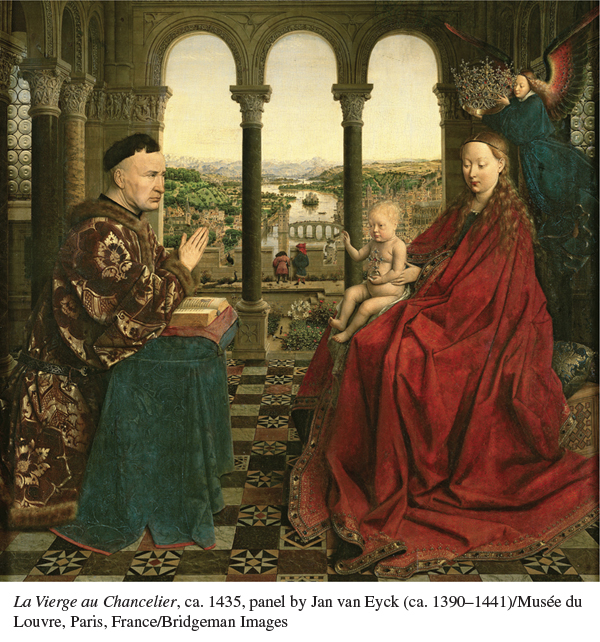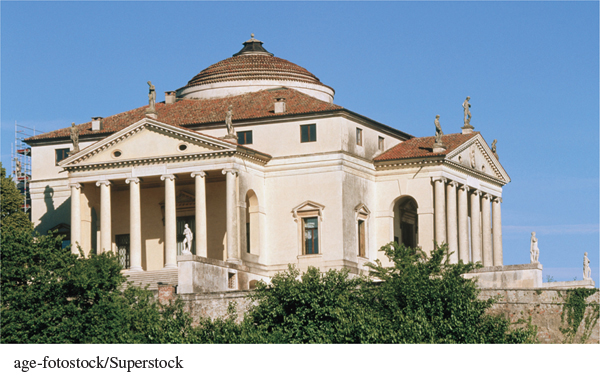Changing Artistic Styles
Both the content and style of Renaissance art often differed from those of the Middle Ages. Religious topics, such as the Annunciation of the Virgin and the Nativity, remained popular among both patrons and artists, but frequently the patron had himself and his family portrayed in the scene. As the fifteenth century advanced and humanist ideas spread more widely, classical themes and motifs, such as the lives and loves of pagan gods and goddesses, figured increasingly in painting and sculpture, with the facial features of the gods sometimes modeled on living people.
The individual portrait emerged as a distinct artistic genre in this movement. Rather than reflecting a spiritual ideal, as medieval painting and sculpture tended to do, Renaissance portraits showed human ideals, often portrayed in the more realistic style increasingly favored by both artists and patrons. The Florentine painter Giotto (JAH-toh) (1276–1337) led the way in the use of realism; his treatment of the human body and face replaced the formal stiffness and artificiality that had long characterized representation of the human body. Piero della Francesca (frahn-CHAY-skah) (1420–1492) and Andrea Mantegna (mahn-TEHN-yuh) (1430/31–1506) pioneered perspective, the linear representation of distance and space on a flat surface, which enhanced the realism of paintings and differentiated them from the flatter and more stylized images of medieval art. The sculptor Donatello (1386–1466) revived the classical figure, with its balance and self-awareness. In architecture, Filippo Brunelleschi (1377–1446) looked to the classical past for inspiration, designing a hospital for orphans and foundlings in which all proportions — of the windows, height, floor plan, and covered walkway with a series of rounded arches — were carefully thought out to achieve a sense of balance and harmony.
Art produced in northern Europe tended to be more religious in orientation than that produced in Italy. Some Flemish painters, notably Rogier van der Weyden (1399/1400–1464) and Jan van Eyck (1366–1441), were considered the artistic equals of Italian painters and were much admired in Italy. Van Eyck was one of the earliest artists to use oil-based paints successfully, and his religious scenes and portraits all show great realism and remarkable attention to human personality. Albrecht Dürer (1471–1528), from the German city of Nuremberg, studied with artists in Italy, and produced woodcuts, engravings, and etchings that rendered the human form and the natural world in amazing detail. He was fascinated with the theoretical and practical problems of perspective, and designed mechanical devices that could assist artists in solving these. Late in his life he saw the first pieces of Aztec art shipped back to Europe from the New World and commented in his diary about how amazing they were.

The Madonna of Chancellor Rolin, ca. 1435 This exquisitely detailed oil painting by Jan van Eyck, commissioned by Nicolas Rolin, the chancellor of the duchy of Burgundy, shows the Virgin Mary presenting the infant Jesus to Rolin, whose portrait in a brocade fur-lined robe takes up the entire left side. The foreground is an Italian-style loggia with an inlaid floor, while the background shows Rolin’s hometown of Autun, where he was a major landowner and where the painting was displayed in his parish church. Renaissance paintings from southern and northern Europe often show their patrons together with biblical figures and highlight exactly the qualities the patron wanted: wealth, learning, piety, and power.
(La Vierge au Chancelier, ca. 1435, panel by Jan van Eyck [ca. 1390–1441]/Musée du Louvre, Paris, France/Bridgeman Images)
In the early sixteenth century the center of the new art shifted from Florence to Rome, where wealthy cardinals and popes wanted visual expression of the church’s and their own families’ power and piety. Renaissance popes expended enormous enthusiasm and huge sums of money to beautify the city. Pope Julius II tore down the old Saint Peter’s Basilica and began work on the present structure in 1506. Michelangelo went to Rome from Florence in about 1500 and began the series of statues, paintings, and architectural projects from which he gained an international reputation: the Pietà, Moses, the redesigning of the plaza and surrounding palaces on the Capitoline Hill in central Rome, and, most famously, the dome for Saint Peter’s and the ceiling and altar wall of the nearby Sistine Chapel.

Villa Capra Architecture as well as literature and art aimed to re-create classical styles. The Venetian architect Andrea Palladio modeled this country villa, constructed for a papal official in 1566, on the Pantheon of ancient Rome (see Chapter 6). Surrounded by statues of classical deities, it is completely symmetrical, capturing humanist ideals of perfection and balance. This villa and other buildings that Palladio designed influenced later buildings all over the world, including the U.S. Capitol in Washington, D.C., and countless state capitol buildings.
(age-fotostock/Superstock)
Raphael Sanzio (1483–1520), another Florentine, got the commission for frescoes in the papal apartments, and in his relatively short life he painted hundreds of portraits and devotional images, becoming the most sought-after artist in Europe. Raphael also oversaw a large workshop with many collaborators and apprentices — who assisted on the less difficult sections of some paintings — and wrote treatises on his philosophy of art in which he emphasized the importance of imitating nature and developing an orderly sequence of design and proportion.
Venice became another artistic center in the sixteenth century. Titian (TIH-shuhn) (1490–1576) produced portraits, religious subjects, and mythological scenes, developing techniques of painting in oil without doing elaborate drawings first, which speeded up the process and pleased patrons eager to display their acquisitions. Titian and other sixteenth-century painters developed an artistic style known in English as “mannerism” (from maniera or “style” in Italian) in which artists sometimes distorted figures, exaggerated musculature, and heightened color to express emotion and drama more intently. (Paintings by Titian can be found in the sections Race and Slavery and Living in the Past: Male Clothing and Masculinity; this is also the style in which Michelangelo painted the Last Judgment in the Sistine Chapel, shown in the section Patronage and Power.)

